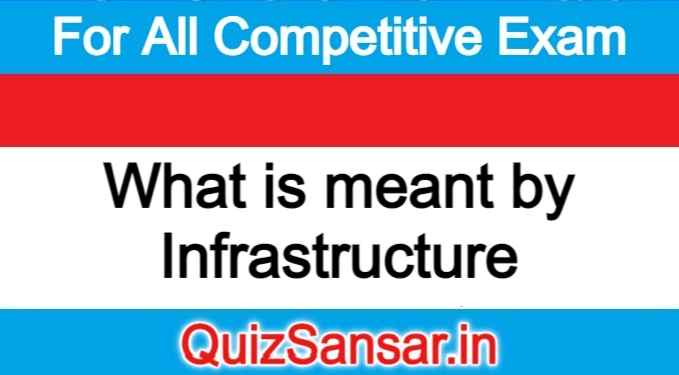
What is meant by Infrastructure
The infrastructure is important for faster economic growth and alleviation of poverty in the country. The adequate infrastructure in the form of road and railway transport system, ports, power, airports and their efficient working is also needed for integration of the Indian economy with other economies of the world.
The following are the important constituents of infrastructure: 1. Power and the source of its production such as coal and oil;
2. Roads and road transport;
3. Railways;
4. Communication, especially telecommunication;
5. Ports and airports; and
6. For agriculture, irrigation constitutes the important. infrastructure.
A distinguishing feature of infrastructure is that while the demand supply gap in case of other factors can be met by importing some of them, the deficiency of infrastructure cannot be made up through imports. Because location-based the need for relevant infrastructure facility can be met through development of its capacity in the domestic economy. For example, you cannot import power facility, roads, ports or railways as they have to be built up in the domestic economy.
Importance of Infrastructure:
It needs to be emphasized that good quality infrastructure is important not only for faster economic growth but also to ensure inclusive growth. By inclusive growth we mean that benefits of growth are shared by the majority of the people of a country. Thus the inclusive growth will lead to the alleviation of poverty and reduction in income inequality in the country.
For example, micro, small and medium enterprises (MSME) are dispersed throughout the economy and production by them and their growth require access to quality and reliable infrastructure services to compete efficiently with large-scale enterprises which can often build some of their own infrastructure such as installing their own small power plants or generators. Besides, large-scale firms can even locate themselves near ports and near transport hubs where required infrastructure is available.
Small enterprises, on the other hand, are dispersed widely in the economy and have to rely on the availability of the general infrastructure facilities. Thus, by building up general infrastructure facilities helps the small enterprises to compete successfully with large-scale industries and being labour-intensive generate large employment opportunities for the workers. This will help to alleviate the poverty in developing countries.
The expansion in infrastructure facilities such as irrigation, rural electrification, roads and road transport will promote agricultural growth and setting up of agro-processing industries. These general. infrastructure facilities will help farmers and owners of processing industries to get their requirements of raw materials, fertilizers and other inputs at cheap rate and also help them to bring their products to the markets which are located in big towns and cities.
Thus, according to Thirlwall, “For poor farmers improved infrastructure will reduce their input cost and increase agricultural production and reduce traders’ monopoly by improving their access to markets. Nearly two-thirds of African far ners are cut off from national and world markets, because of poor infrastructure and market access. Better transport means greater access to public resources including schools, hospitals and other health facilities”.
It follows from above that the expansion of infrastructure facilities will ensure sustained growth of employment in agriculture and small scale rural industries and bring prosperity in the rural areas and in this
way ensure inclusive growth. Besides, this will also help to prevent the mass exodus of the rural people to urban areas where they cause problems of urban congestion, growth of slums and acute housing shortage.
Lack of adequate infrastructure not only holds lack economic development, it also causes additional costs in terms of time, effort and money of the people for accessing essential social services such as healthcare and education. Emphasizing the importance of adequate infrastructure, authors of Economic Survey of India for the Year 2013 14 quite rightly write, “Rural economic growth in recent years has put enormous pressure on existing infrastructure particularly on transport, energy and communication. Unless it is significantly improved infrastructure will continue to be a bottleneck for growth and obstacle to poverty reduction”. In other words, it is the challenge to ensure strong, sustainable and balanced development through integration of the economy with environmentally sustainable development of infrastructure.
It may be noted that with large investment in infrastructure during the last decade (2003-04 to 2013-14) India has become the second fastest growing economy of the world but in the two years (2012 March 2014) economic growth slowed down and this has been mainly due to the stalled infrastructure projects which held back economic development. It is therefore urgently needed that infrastructure projects be given environment clearance quickly and investment in them be speeded up if the Indian economy is to be brought back on the fast growth trajectory.
The availability of good quality infrastructure raises productivity levels in the economy and brings down costs of the enterprises. Besides, the availability of adequate infrastructure helps to expand trade not only within a country by improving transport facilities but also promote foreign trade through improvement of ports and airports. It also helps to diversify production by the firms as they are able to get
the required supplies of raw materials and other inputs from the places where these are available in abundance. Furthermore, with improved infrastructure the firms can produce goods in accordance with the demands of the people of different regions and countries.
According to World Bank estimates, in the year 2008 developing countries made investment of around $ 500 billion a year in new infrastructure-transport, power, water, sanitation, telecommunication, irrigation and so on equal to 20 per cent of GDP but the need for infrastructure investment is still large. In developing countries one billion people still lack access to clean water, two billion people lack access to sanitation and electric power and adequate transport facilities are still lacking in developing countries.






